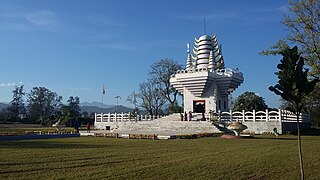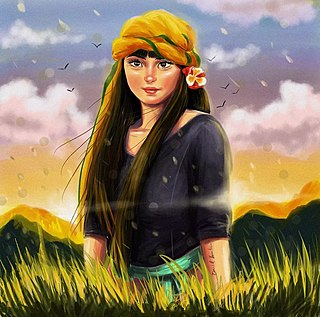Indian literature refers to the literature produced on the Indian subcontinent until 1947 and in the Republic of India thereafter. The Eighth Schedule to the Constitution of India has 22 officially recognised languages. Sahitya Akademi, India's highest literary body, also has 24 recognised literary languages.

The Meitei script, also known as the Kanglei script or the Kok Sam Lai script, after its first three letters is an abugida in the Brahmic scripts family used to write the Meitei language, the official language of Manipur, Assam and one of the 22 official languages of India. It is first known from engravings on 6th century CE coins and copper plate inscriptions. as verified by the various publications of the National Sahitya Akademi. It was used until the 18th century, when it was replaced by the Bengali alphabet. A few manuscripts survive. In the 20th century, the script was revived and is again being used. Beginning in 2021, the Government of Manipur began to use the Meitei alongside the Bengali-Assamese script, per the Manipur Official Language (Amendment) Act, 2021.

Meitei literature, also known as Manipuri literature, is literature written in the Meitei language of Manipur. An ancient institution of learning, the Luwang Nonghumsang, later known as the Pandit Loishang, collected sources of indigenous Meitei knowledge and philosophy until the 18th century. Writing by Meiteis is assumed to go back to the Kingdom of Kangleipak in the early 12th century. The Meitei script is a Brahmic abugida. It is known only from the Puya manuscripts discovered in the first half of the 20th century. Manuscripts of the 18th and 19th centuries were written using the Bengali alphabet. The existence of the Meitei script in the 15th-century hinges on the authenticity of an inscription dated to the reign of Senbi Kiyamba. The first printed Manipuri book, Manipurer Itihas, appeared in 1890 from the Baptist Mission Press, Calcutta. Though the kings of Manipur had established contact with the British from the middle of the eighteenth century onward the real impact of the contact came much later. Johnstone Middle English School, based on the western system of education, was started in 1885 at Imphal, and in 1891 Manipur lost its independence to the British. British domination facilitated the introduction of new systems in the civil, political and educational spheres, which hastened the process of modernization in Manipur, exposed as it was to new ideas and influences.

Panthoibi, also known as Nongpok Leima, is a goddess associated with civilization, courage, fertility, handicraft, love, victory, warfare and wisdom in the mythology and religion of Ancient Kangleipak. She is a consort of the God Nongpok Ningthou. She is considered to be one of the divine incarnations of Leimarel Sidabi and is also identified as a form of Goddess Nongthang Leima. She is worshipped mainly by the Meitei people in Manipur, Assam, Tripura, Bangladesh and Myanmar.

Nongshaba is a lion god in Sanamahism and Meitei mythology. He is also regarded as a king of the gods. He is credited with producing light in the primordial universe and is regarded as the maker of the sun. He is worshipped by the people of both the Ningthouja clans as well as the Moirang clans. Nongshaba was worshipped by the people of Moirang clan as a lineage deity and regarded as the father of the god Thangching. He is the greatest of the Umang Lais but he made his only son Thangching the chief deity of Moirang.

Nongpok Ningthou, also known as the Sovereign of the East or King of the East, is a deity in Sanamahism, the indigenous religion of Manipur. He is the ruling guardian deity of the eastern direction. Legend says Nongpok Ningthou and his consort Panthoibi were united in the Nongmaiching Ching mountains. Later, they were worshipped as the civilization giving deities in Meitei religion.

Phouoibi or Phouleima is the goddess and the female personification of the agriculture, crops, fertility, grains, harvest, paddy, rice and wealth in Meitei mythology and religion of Ancient Kangleipak . She is the lover of Akongjamba, a hero in ancient legends. But fate does not permit the lovers to unite. So, Phouoibi and Akongjamba reincarnated in the legends. She was sent by Thangching to Moirang) kingdom to make the human world prosperous. The legends of her love with Akongjamba were believed to be enacted by Thangching as a part of the Moirang Saiyon legends.

Phou Ningthou is a deity in Sanamahism, the indigenous religion of Manipur). He is the God and the divine male personification of the agriculture, crops, fertility, grains, harvesting, rice paddies, rice and wealth. He is the consort of Phouoibi (Phouleima), the goddess of crops and agricultural fertility.

Nongda Lairen Pakhangba, was the first Meitei monarch of the Ningthouja dynasty, who ascended the throne of the Kangla of Kangleipak realm) in 33 AD, after the withdrawal of the mainstream powers of the Khabas. Before the reign of king Nongda Lairen Pakhangba, the clans, or salais were already in existence.

The ancient legend of Khuyol Haoba and Yaithing Konu is one of the epic cycles of incarnations of Meitei mythology and folklore, that is originated from Moirang kingdom of Ancient Kangleipak. It concerns the fateful love of Khuyol Haoba, an orphan man, for the beautiful Yaithing Konu. Khuyol Haoba was the son of late Khundouremba, a court official of Moirang. Yaithing Konu was the daughter of Luwang Huiningsumba, an influential nobleman of Moirang.

The culture of Meitei civilization evolved over thousands of years, beginning in Ancient Kangleipak, continuing most notably into Medieval Kangleipak, while influencing the neighboring states and kingdoms, till present times.

The Khongjomnubi Nonggarol is an ancient Meitei language literary narrative text (puya) containing two major stories, first about a group of six Luwang girls turning into the pleiades in the sky, one of them giving birth to a harinongnang and the second about a lady named Haosi Namoinu turning a harinongnang, unable to suffer the extreme cruelty of her stepmother, during her father's absence.

Leithak Leikharol, also spelt as the Leithak Leikhalol, is an ancient literary narrative work (puya), about the creation of the universe, genealogy of kings, moral teachings and mythology. It mentions some goddesses including Leimarel Sidabi, Nongthang Leima and Panthoibi. Goddess Leimarel Sidabi is said to be the omniscient. It states that goddess Panthoibi slays a demon.

The Phouoibi Waron or Phouoibi Warol is a Medieval Indian Meitei text (Puya) written in a period between 13th and 14th century AD. It deals with the life story of the lovers of Phouoibi, the goddess of agricultural crops and harvest in Meitei mythology and religion (Sanamahism).
Meidingu Hongnemyoi Khunjao Naothingkhong was a Meetei ruler of Ningthouja dynasty of Ancient Manipur. He was the successor of Ura Konthouba and the predecessor of Khongtekcha. He ran away from the Kangla at the age of about 10 or 12 years and went to live along the Shelloi Langmais in the Nongmaiching Hill in the eastern Manipur. He was mad in love with Pitang-nga, a Langmai girl and married her. They lived in her parents' house. This is the first reference to the matrilocal residence in the history of Manipuri ethnicity. According to ancient sources, he has six wives from different clan principalities of Ancient Manipur. In fact, he has nine total wives, out of which three are childless. So, in general cases, it is regarded as he has six wives. He married Princess Ewanglon Namun Chaobee after engagement. Luwang Ningthou Punshiba of Luwang dynasty gave training of state craft and the art of governance to Naothingkhong when he was a prince. Besides, the great-grandson of Luwang Ningthou Punshiba married Naothingkhong's daughter.

The Loiyumpa Silyel, also termed as the Loyumpa Silyel or the Loiyumpa Shilyel or the Loyumpa Shilyel or the Loyumba Sinyen, is an 11th-12th century ancient Meitei language written constitution, regulated in the Ancient Kangleipak during the rule of King Loiyumba. In 1110 CE, its format was finalised from a promulgation of the proto-constitution, drafted in 429 CE by King Naophangba. Historically, it is the first written constitution, and one of the well recorded Ancient Meitei language texts of the kingdom. It was replaced by the Manipur State Constitution Act 1947, that was functional until Manipur was merged into Republic of India on October 15, 1949.
The Chainarol, also known as the Chainalol, is an ancient Meitei language text (puya) which records the armed combats of various gladiators through different periods of history of Ancient Kangleipak. It consists of 27 stories of real life incidents of the dual fight between different gladiators.

Women have significant roles in different elements of Meitei culture, including Meitei dances, Meitei festivals, Meitei folklore, Meitei folktales, Meitei literature, Meitei mythology, Meitei religion, etc.

Ancient Meitei literature, also termed as Old Manipuri literature, is literature written in the Old Manipuri language from the earliest texts until the time of King Pamheiba. All the ancient Meitei literary works are written in the traditional Meitei script. The ancient Meitei language texts, written in Meitei script, are conventionally termed as "the puyas".

The cultural heritages of Meitei civilization has classicism in diverse traditions of cinemas, dances, language, literature, music, theatre, etc.












